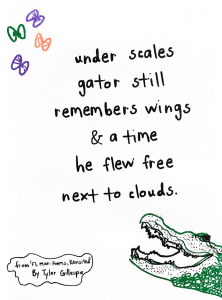During a recent poetry/memoir panel at ReadOUT, an audience member asked about my poetry prints.
The poet wanted to know: 1) if I write poems with prints in mind (meaning, do I specifically craft a poem’s lines thinking it will be good for a print), and 2) about my process for deciding when to make a full broadside poem or use a line(s) from one on a print.
The first question – about crafting lines for prints – is easy for me to answer.
No.
I’m too interested in what the poem can do as a thing itself – as an aesthetic object, as a vehicle to convey an emotion/idea.
Currently, I don’t put any pressure on a poem to become a print. I don’t want to force lines into a poem just because I think they would look good on a wall. (But maybe I should!).
That being said, my poems often contain what some people have called “punchy lines” – a turn of phrase or striking image to keep readers/the audience on their toes. My poem shadow boxes with them; it tries for a knockout.
Or, at least, the poem wants to get readers with the right hook.

The second question – about when I use a line or full poem – is a little more difficult to answer.
It depends.
Right now, I choose to make a print with either a full poem or a line(s) from one based on 1) the time I have to create it, 2) the visual impact I want to achieve, and 3) how I see the prints circulating in terms of size.
I’ve made standard-size prints for a wall and smaller, “pocket poetry prints” like this post’s gator and fruit print, which is included with pre-orders for my forthcoming book Florida Man: Poems, Revisited.

I’ve also made broadsides for full poems as I did for “on a day i’m feeling especially bummed about florida” (the featured image of this post).
To make this broadside, I created a font from my handwriting because I wanted some consistency in the letters. This custom font meant it took me a long time to get the poem on the page as I had to copy and paste each letter.
I arranged the poem and then chose moments to illustrate and visually punctuate the images.
After I had the final poem layout in black-and-white, I added a gradient in Photoshop.
I then printed the poem on a risograph using black, fluorescent pink, and yellow.
This process took me a long time, but I wanted to make a broadside for the full poem, in part, to help readers see the poem’s “horizon full of sherbert.”





